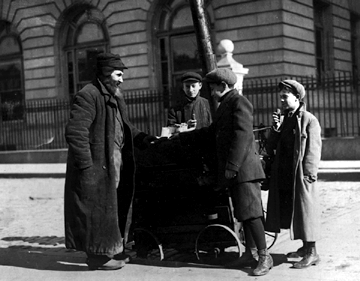Vendors and Markets
We are indebted to The NY Food Museum for the transfer of their archives to the City Food Research Group as a resource and foundation for historical research of NYC’s food system. Special thanks to Nancy Ralph, NY Food Museum’s founder, as well as to Suzanne Wasserman and Carol Durst for their work on vendors and markets presented here.
The NY Food Museum began its activities in the fall of 1998, presenting a range of exhibitions on the history of New York City’s food supply. Its mission to encourage people to think about the food they eat, to learn about its sources and to connect with the people who grow, raise, catch, find, and purvey their food and who cook, serve and clean up their meals. The museum’s exhibits supported public understanding of the importance of food in society and they addressed related issues of labor, class, religion, race, gender, food security and ecology
Markets and pushcart histories have always been intertwined. New York’s marketing past includes the development and demise of pushcart markets, groups of peddlers who came each day to one location to sell wares from socks and shoes to ready-to-eat delicacies.
In colonial times, New Amsterdam’s first marketplace was a band of country settlers and traders (named “Strangers” by the more urban Dutch) and Native Americans who sold corn, pelts and fish on 100 feet of vacant land between the West India Company’s warehouse and Fort Amsterdam.
As tobacco was the ruling crop, European settlers often endured food shortages, waiting at the East River landing or along the shore from Whitehall to Broad Street for farmers and Native American traders to arrive from Brooklyn and Long Island. The markets near the landings became chaotic, and in 1656, officials created the first public open-air market on Pearl Street, where vendors kept regular stalls each Saturday.
New York City’s population climbed from 400,000 in 1840 to 2 million in 1880. Nearby farmers could not meet the demand, and up to 300 carloads of produce came in by railroad and steamship daily from all over the country and abroad. Frequent gluts created an opportunity for pushcart peddlers, who sold the surplus in new stationary pushcart markets.
Officially, peddling in one spot for longer than 30 minutes was illegal, but vendors defied the law in the most crowded neighborhoods. In 1886, four pushcarts appeared on Hester Street and stayed there. More pushcart markets soon opened; Paddy’s Market on Ninth Avenue, Grand Street, Orchard Street and Rivington Street Markets. For the next fifty years, the pushcart markets were an integral part of New York City life, especially in immigrant neighborhoods
Pushcart vendors sold ready-to-eat food and fruits and vegetables in densely populated neighborhoods. In Manhattan, the largest pushcart markets were on the Lower East Side. 25,000 pushcart vendors made their living selling food and dry goods.
A Pushcart Commission was established in 1905 (and then again in 1912). It recommended regulations to alleviate traffic problems and eliminate police graft and an informal store “padrone” system of payoffs and other “evils” associated with the extensive pushcart scene.


From the commission’s 1905 report (See full report HERE) :
“It is not perhaps generally known that in certain streets known as ” market ” streets, there are all day long and well into the evening, unbroken lines of push-carts on each side of the street extending from one block to another; the Commission in its investigations, for example, found sixty-four push-carts at one time on one block, viz. : on Orchard street, from Rivington to Stanton streets, and on the next block on the same street, from Stanton to Houston streets, fifty additional carts. This congestion of peddlers is in no way general throughout the city, however, but occurs in very clearly defined neighborhoods or localities. The greatest congestion exists in the most crowded quarters of the city the lower east side, and especially in the Hebrew quarter.” […]
“While adding materially to the picturesqueness of the city’s streets and imparting that air of foreign life which is so interesting to the traveler, lending an element of gaiety and charm to the scene which is otherwise lacking, the practical disadvantages from the undue congestion of peddlers in certain localities are so great as to lead to a demand in many quarters for the entire abolition of this industry, if it may be dignified by that term.”